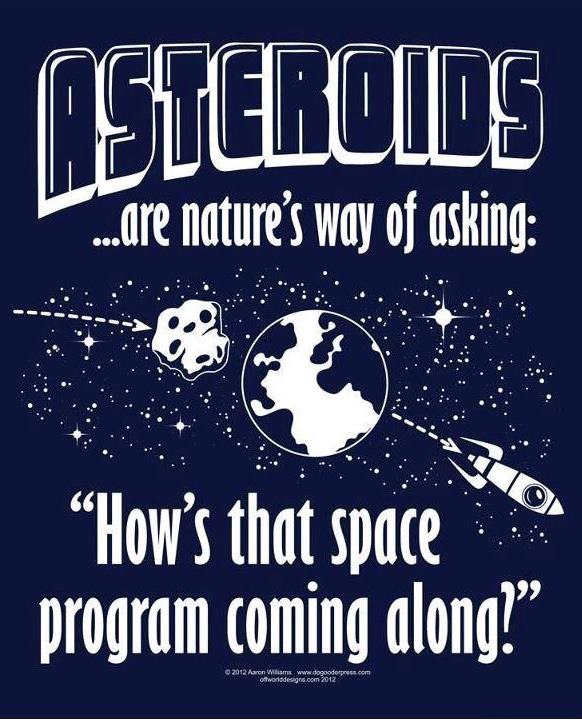So this is little different than my science-travel posts, but with the recent near-earth approach of Asteroid 2012 DA14 on Feb 15th 2013, and on the same day (but unrelated) a bus-sized meteor crashed into Russia’s Ural mountains, there has been a spotlight on extraterrestrial threats to earth. Thus, this post is going to be all about boilde impacts, i.e. space rocks!
Asteroid 2012 DA14 was the closest encounter we’ve seen in recently times (at a distance of <28,000km from earth), however, all these near misses begs the question, how safe are we?
Impact events are frequent bombardments of extraterrestrial rocks that have been occurring since the formation of the solar system. Need evidence? Just look at the moon and all its craters. Luckily, earth has plate tectonics, oceans and erosion to mask these same scares that plague our lunar companion.
Asteroids DA14 did not hit earth (clearly…), but what happens if or when one of these objects does? As a meteor falls to the earth, it gets slowed down by the atmosphere. Unfortunately, objects larger than 10m are not stopped by the atmosphere and make contact. The after effects are, well… not encouraging.
What is the difference between meteors, asteroids and comets?
Before I go into the effects of these space rocks if they hit, first here is a quick clarification of the commonly confused differences between meteors/meteoroids, asteroids, and comets.
Asteroids
Asteroids are ‘minor planets’, >10 metres, within or originated from the Asteroid belt between Mars and Jupiter.
Comets
Comets are clumps, >10 kilometres, made of ice, snow and dust (these leave brilliant trails in the sky and are easily evaporated when entering the atmosphere)
Meteors
Meteoroids are smaller than asteroids, <10 meters. When they are in the atmosphere and start to burn up (i.e. leave a streak of light) it is called a meteor. Not until it hits the earth is it then dubbed a meteorite). Iron-meteorites, or ‘stony-meteorites’, are fairly common and these can be quite deadly. When looking at these rocks, they are sometimes deemed chondrites.
What would happen if they hit earth?
If any of these are large enough and impact earth, the results can be devastating and range from short term effects like fires and shock waves, to long term effect such as climate change and mass extinction.
Short Term:
Short term effects happen at the same time as the impact, and the most obvious is the initial blast wave. This is a high power shock wave that destroys nearby objects in an instant do to the kinetic force of the meteor hitting the ground. Other local effects cause by the initial hit can be tsunamis, wild fires, and thermal heat that can melt and vaporize the surrounding area.
Medium Term:
Medium term effects last days to months, and are just as devastating. When an impact occurs, aerosols and dust are injected in the atmosphere (such as sulphur dioxide). This causes a ‘nuclear winter’ blocking out sunlight and causing massive cooling.
Long Term:
Finally, these long term effects are the silent killers, for they may not be what you first think of when you imagine an impact event, but they are the ones that effect the environment the most in terms of climate change, and possibly even cause mass extinction events (such as the KT boundary impact that ended the dinosaurs reign some 65.5 million years ago).
Just how toxic these long term effects can be are the result of fire and decaying organic matter that would inject greenhouse gases such as CO2 and CH4 into the atmosphere, and nitrogen oxides can be injected into the stratosphere, and this can cause a large amount of ozone destruction, thus leading the planet to a more susceptible state, exposed to harmful UV rays which can damage life on earth.
What are the chances of hitting earth?
Concerned yet? It’s scary to think just how often these events occur. In fact, there is a 1 in 20,000 chance of being killed by an impact in your life time (though this number is hotly debated, and some put it around 50,000 to 200,000…). To put that in perspective, it’s about the same chance you have of being killed in an airplane, though we tend to fear the latter a lot more than the former.
Fortunately, NASA in 1998 established the Near-Earth Objet Program Office at JPL to essentially track the skies and detect oncoming hazardous asteroids that could threaten earth. But, they only track the large ones, so the little but deadly ones can still sneak by theoretically… if they aren’t small enough to dissolve in the atmosphere that is.
It is important to note that along with identifying threat, the Near-Earth Object Program allows scientist to study these passing asteroid for important research, and possibly future resource (some day… they need geologists to study space rocks right)?
Final thoughts
Finally, with the near-miss of Asteroid DA14 you may wonder, “just how do you stop an asteroid from hitting earth”? Well, I’ll stop here and let your imaginations run wild with that one…
So even though an impact can cause a global extinction like the dinosaurs so sadly experience, I wouldn’t go living the rest of your life in an underground bunker in fear, just be aware that we are not the only bodies of rock floating around in this area of space, and in the meantime, keep watching the skies.
-Stephanie
Thanks for reading! Please subscribe for more posts via email, and/or leave a comment, share this post, or follow me on Twitter (@stephsykora) or Instagram (@stephaniesykora)













I like your post Stephanie, they are rich in content.
Thanks! Hopefully I made them not overly wordy, glad you enjoyed it 😉
Thanks for clarifying this meteors/meteoroids, asteroids, and comets thing 🙂
Your welcome! The meteoroid vs meteorite vs meteor terms are always a bit confusing I found with others 🙂